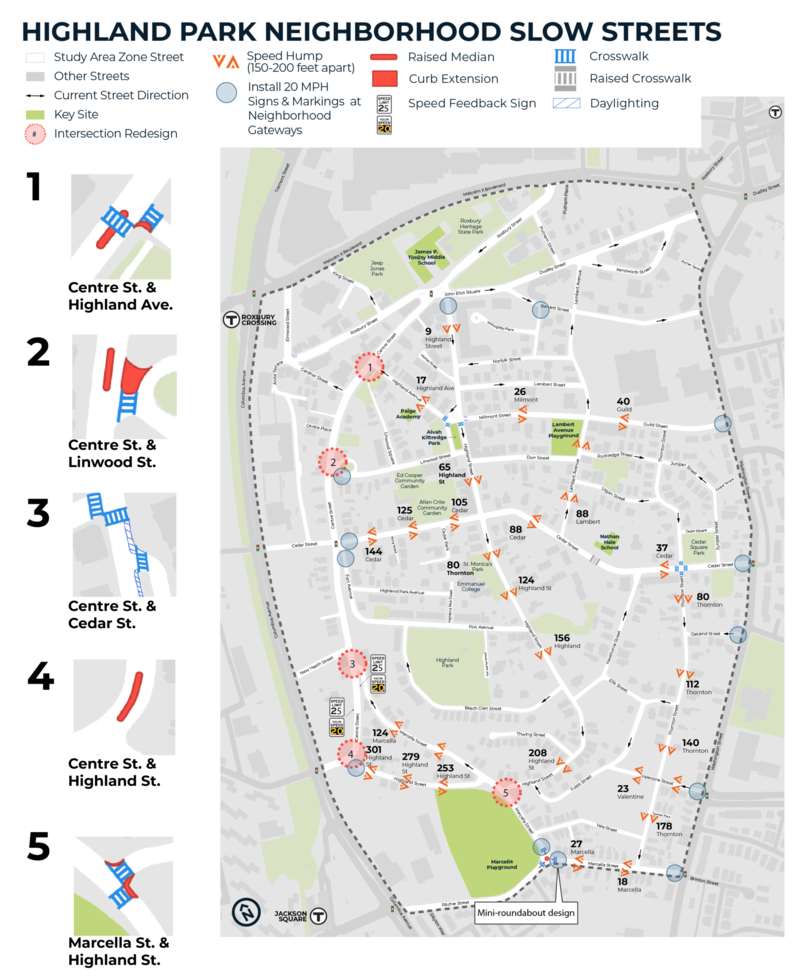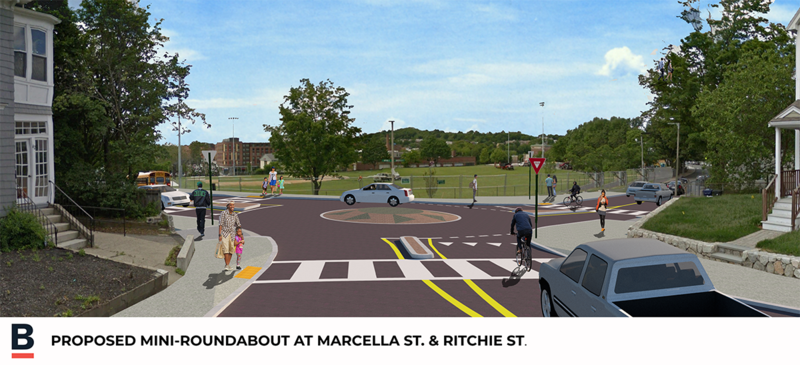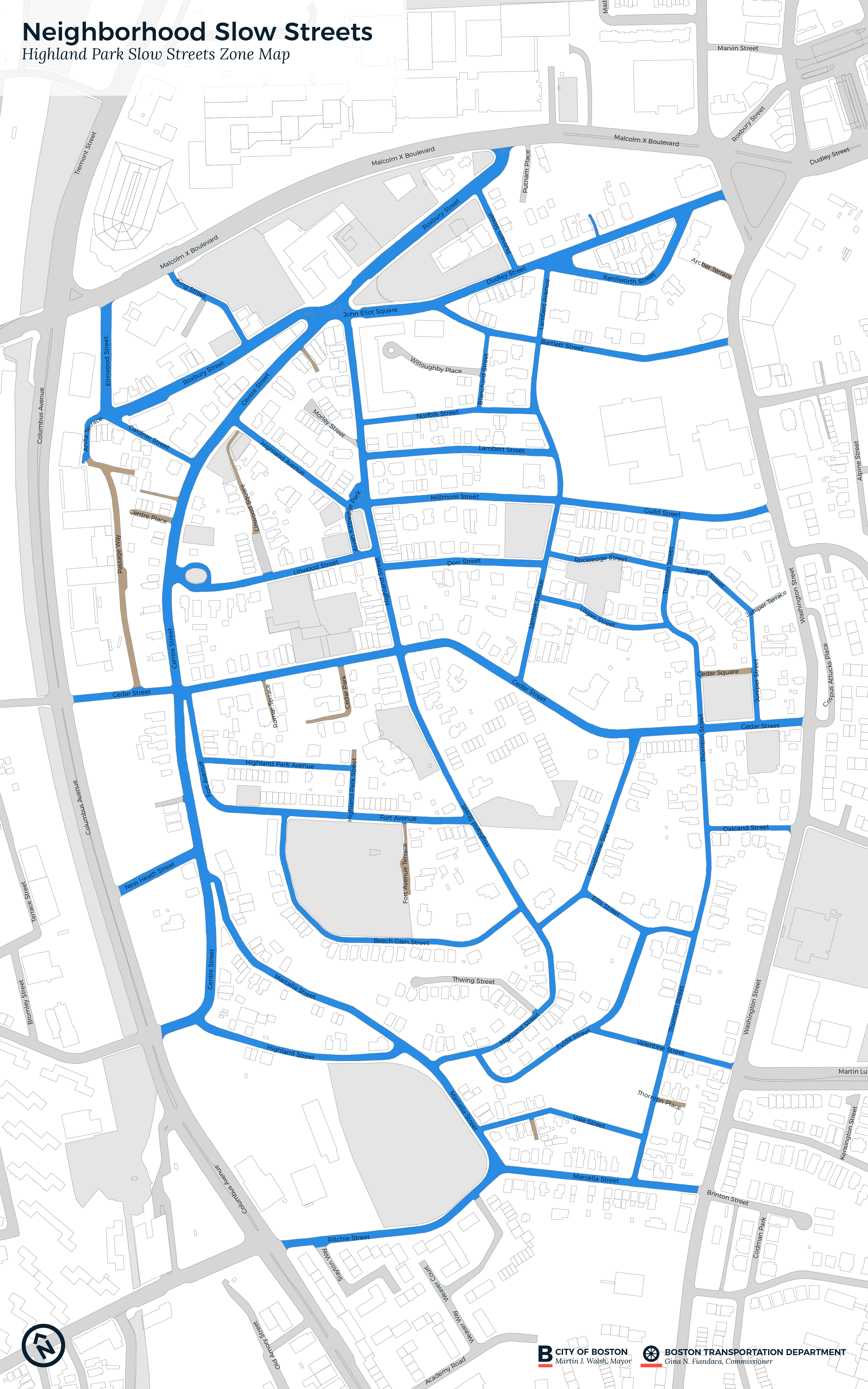Highland Park
This page contains information about the Neighborhood Slow Streets plan for the Highland Park neighborhood.
Neighborhood Slow Streets is a new approach to traffic calming requests in Boston. We're focused on street designs that self-enforce slower speeds and safer behaviors. Through this program, we aim to:
- reduce the number and severity of crashes on residential streets
- lessen the impacts of traffic, and
- add to the quality of life in our neighborhoods.
Highland Park is one of five communities that was selected to join the program in 2017.
2021 construction season
Construction crews began working in Highland Park in 2021.
Over the winter months, new drainage connections were made ahead of curb extensions and new crosswalk locations.
In early summer, we began to install speed humps on several streets. We aim to complete this work by the end of October 2021.
We also constructed safer crosswalks at the intersection of Marcella Street and Highland Street. We built a raised crosswalk on Centre Street near the Nathan Hale School.
We will construct the following elements in 2022:
- Highland Avenue at Centre Street: crossing island and curb extension
In 2022, we will advance engineering design for:
- Ritchie Street at Marcella Street: mini roundabout and curb extensions
A future capital project will revisit the design options for:
- Centre Street at Linwood Street: accessible crosswalk along Centre Street
Centre Street Traffic Calming
In response to community requests, we hosted a virtual public meeting on July 20. In this meeting, we reviewed the Neighborhood Slow Streets process for the Highland Park zone. We shared details about our design plans for Centre Street. We spoke together in small groups to share concerns and ideas. No decisions were made in this meeting.
Over the coming weeks, we will review all comments we have heard from residents. We will summarize what we heard and share it on this website and via our email list. We will communicate our findings and possible changes to the design plans to the neighborhood. Please note that at this late date, we have limited capacity to make major changes.
All construction for Centre Street is paused, but continues in other parts of the neighborhood.
View the plan!
View the changes in the Highland Park Neighborhood Slow Streets Zone, coming this year!
Closer look
Key components
View the changes for Highland Park, and recent updates made based on feedback.
Ritchie and Marcella intersection
View the design for creating a safer intersection at Ritchie Street and Marcella Street.
Bus stop consolidation
In addition to adding crossing safety improvements on Centre Street, we'll consolidate bus stops to improves service times on the 14 and 41 routes.
Project history
Project historyBased on community feedback, we will design a mini-roundabout at Marcella Street and Ritchie Street.
As part of our Neighborhood Slow Streets project, we shared two options for slowing traffic and improving safety at the intersection:
- a mini-roundabout, or
- an all-way stop.
We heard neighbors’ preference for the mini-roundabout over the three-way stop option at community meetings and in our online feedback form. The mini-roundabout design:
- slows traffic while allowing continuing traffic flow
- requires drivers to yield to people crossing the street, and
- allows large vehicles, such as buses and trucks to drive over the mini-roundabout if necessary.
After the May 17, 2018, public meeting, we collected feedback on the focus areas through an online survey. Community members were asked to share their ideas for:
- improving crossing Center Street on foot
- managing traffic flow through the southern part of the neighborhood
- improving safety on Cedar Street near the Nathan Hale school
- improving safety on Millmont Street and Guild Street, and
- reducing speeds and improving safety on their street or at other locations.
We met with residents from 6 - 8 p.m. at the Hawthorne Youth and Community Center at 9 Fulda Street.
*Speed data are available in the presentation.
We joined community members for a neighborhood walk on Monday, September 25, at 5:30 p.m. We started at the Roxbury Crossing MBTA stop. What we learned from the walk will supplement information:
- received in the application
- reported through the Vision Zero Safety Concerns map, and
- collected through speed and volume studies.
Neighbors were welcome to join all or some of the walk. The walk was not the only time or place that neighbors can provide input on the Neighborhood Slow Streets project. Neighbors can also share their concerns at future public meetings about the project.
Highland Park Neighborhood Slow Streets Map
Zone streets* - Streets that we will evaluate for traffic calming improvements
Private ways - Streets that are privately owned, so we will not be able to make changes to them
Other streets - Streets that are outside of the zone, regardless of who owns them, or streets that are within the zone boundaries and will not be evaluated for traffic calming
*All streets that we will consider for changes are marked as "zone streets." During the planning process, we may determine that some streets won’t see any changes. We generally will not consider any additional streets that are not marked as “zone streets."
2017 application period
2017 application periodNeighborhood Slow Streets prioritizes street safety improvements in areas with:
- a history of serious crashes
- a high number of residents more likely to be killed or seriously injured walking or biking like children, older adults, and people living with disabilities
- places people walk or bike to, including schools, libraries, parks, community centers, bus stops, or transit stations, and
- existing or planned opportunities for walking, biking, or taking transit.








